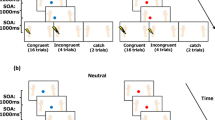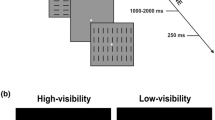Abstract
We investigated the interaction between anticipation of positive and negative affective images and visual evoked magnetic fields (VEF). Participants (n = 13) were presented emotionally positive or negative images under different anticipatory conditions, and their subsequent brain responses were recorded by magnetoencephalography (MEG). In the Affective Cue conditions, the cue stimulus indicated the emotional valence of the image, which followed 2 s later. In the Null Cue conditions, the cue stimulus did not include any information about the valence of the image. In the No Cue conditions, the affective image was suddenly presented, without a cue stimulus. The VEF amplitude for the negative image in the Affective Cue condition was smaller than that of the positive image in the Affective Cue condition and that of the negative image in the Null Cue condition. This result suggests that anticipation of the valence of affective images modulates the processes of the visual cortex.






Similar content being viewed by others
References
Basile LF, Rogers RL, Bourbon WT, Papanicolaou AC (1994) Slow magnetic flux from human frontal cortex. Electroencephalogr Clin Neurophysiol 90:157–165
Brenner D, Williamson SJ, Kaufman L (1975) Visually evoked magnetic fields of the human brain. Science 190:480–482
Costa M, Braun C, Birbaumer N (2003) Gender differences in response to pictures of nudes, a magnetoencephalographic study. Biol Psychol 63:129–147
Cuthbert BN, Schupp HT, Bradley MM, Birbaumer N, Lang PJ (2000) Brain potentials in affective picture processing, covariation with autonomic arousal and affective report. Biol Psychol 52:95–111
Dammers J, Ioannides AA (2000) Neuromagnetic localization of CMV generators using incomplete and full-head biomagnetometer. Neuroimage 11:167–178
Desimone R, Duncan J (1995) Neural mechanisms of selective visual attention. Annu Rev Neurosci 18:193–222
Ekman P (1992) An argument for basic emotions. Cogn Emot 6:169–200
Elbert T, Rockstroh B, Hampson S, Pantev C, Hoke M (1994) The magnetic counterpart of the contingent negative variation. Electroencephalogr Clin Neurophysiol 92:262–272
Gomez CM, Fernandez A, Maestu F, Amo C, Gonzalez-Rosa JJ, Vaquero E, Ortiz T (2004) Task-specific sensory and motor preparatory activation revealed by contingent magnetic variation. Brain Res Cogn Brain Res 21:59–68
Hultin L, Rossini P, Romani GL, Hogstedt P, Tecchio F, Pizzella V (1996) Neuromagnetic localization of the late component of the contingent negative variation. Electroencephalogr Clin Neurophysiol 98:435–448
Keil A, Bradley MM, Hauk O, Rockstroh B, Elbert T, Lang PJ (2002) Large-scale neural correlates of affective picture processing. Psychophysiology 39:641–649
Keil A, Muller MM, Gruber T, Wienbruch C, Stolarova M, Elbert T (2001) Effects of emotional arousal in the cerebral hemispheres, a study of oscillatory brain activity and event-related potentials. Clin Neurophysiol 112:2057–2068
Keselman HJ (1998) Testing treatment effects in repeated measures designs: an update for psychophysiological researchers. Psychophysiology 35:470–478
Koyama T, McHaffie JG, Laurienti PJ, Coghill RC (2005) The subjective experience of pain, Where expectations become reality. Proc Natl Acad Sci USA 102:12950–12955
Lang PJ (1995) The emotion probe, Studies of motivation and attention. Am Psychol 50:372–385
Lang PJ, Bradley MM, Cuthbert BN (1998) Emotion, motivation, and anxiety: brain mechanisms and psychophysiology. Biol Psychiatry 44:1248–1263
Lang PJ, Bradley MM, Cuthbert BN (1999) International affective picture system (IAPS), technical manual and affective ratings. University of Florida, Gainesville
LeDoux JE (1987) Emotion. In: Plum F (ed) Handbook of physiology. American Psychological Association, Bethesda pp 419–460
Nitschke JB, Sarinopoulos I, Mackiewicz KL, Schaefer HS, Davidson RJ (2006) Functional neuroanatomy of aversion and its anticipation. Neuroimage 29(1):106–116
Pessoa L, Kastner S, Ungerleider LG (2003) Neuroimaging studies of attention, from modulation of sensory processing to top-down control. J Neurosci 23:3990–3998
Regan M, Howard R (1995) Fear conditioning, preparedness, and the contingent negative variation. Psychophysiology 32:208–214
Schupp HT, Junghofer M, Weike AI, Hamm AO (2003) Attention and emotion, an ERP analysis of facilitated emotional stimulus processing. Neuroreport 14:1107–1110
Shigeto H, Tobimatsu S, Yamamoto T, Kobayashi T, Kato M (1998) Visual evoked cortical magnetic responses to checkerboard pattern reversal stimulation: a study on the neural generators of N75, P100 and N145. J Neurol Sci 156:186–194
Simmons A, Matthews SC, Stein MB, Paulus MP (2004) Anticipation of emotionally aversive visual stimuli activates right insula. Neuroreport 15:2261–2265
Simpson JR Jr, Drevets WC, Snyder AZ, Gusnard DA, Raichle ME (2001) Emotion-induced changes in human medial prefrontal cortex, II During anticipatory anxiety. Proc Natl Acad Sci USA 98:688–693
Swithenby SJ, Bailey AJ, Brautigam S, Josephs OE, Jousmaki V, Tesche CD (1998) Neural processing of human faces: a magnetoencephalographic study. Exp Brain Res 118:501–510
Ueda K, Okamoto Y, Okada G, Yamashita H, Hori T, Yamawaki S (2003) Brain activity during expectancy of emotional stimuli, an fMRI study. Neuroreport 14:51–55
Author information
Authors and Affiliations
Corresponding author
Additional information
This research was supported by a Grant-in-Aid to Keiichi Onoda from the Japan Society for the Promotion of Science for Young Scientists.
Rights and permissions
About this article
Cite this article
Onoda, K., Okamoto, Y., Shishida, K. et al. Anticipation of affective image modulates visual evoked magnetic fields (VEF). Exp Brain Res 175, 536–543 (2006). https://doi.org/10.1007/s00221-006-0569-5
Received:
Accepted:
Published:
Issue Date:
DOI: https://doi.org/10.1007/s00221-006-0569-5




